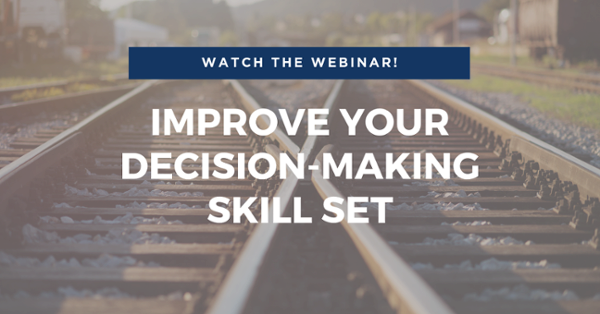In this article

Written by Jonathan Allen
As a leader, some days you may wish you had all the answers.
And rightfully so. Some of the best leaders are the best decision makers.
So, if you’re like me, you might imagine yourself sitting in your office – furrowed brow, rubbing your chin, carefully contemplating the options of a monumental, far-reaching decision in front of you. In your mind’s eye, you see yourself a few hours later. Against all odds, you have single-handedly come up with a solution no one ever thought of. You walk out of the office triumphant! Maybe a rousing 2-minute speech ensues, and amidst the cheers of your followers, the decision is carried out with complete buy-in and impeccable execution.
OK, maybe not that dramatic. But we all want to make the right decisions, right?
Here’s another one: You’re in a crisis situation. Many lives are at stake. Panic-stricken people, your people, are rushing past you. You usually have the answers, so your followers anxiously look to you. You size up the situation, think quickly, and courageously make a judgment call. Against all odds, you come up with the answer no one considered. You succeed brilliantly, based on your intuition and sheer wit, in an impossible situation. Needless to say, you come out of it the hero.

These fantasies of great leaders might stem from Hollywood, or from tales of historical figures we know and love. Some of these stories are true, and the leaders who stepped up in such pressure situations are admirable.
In our day, however, the traits of an effective decision maker are not necessarily what you might think. Most decisions, and the processes surrounding them, can’t possibly be made in isolation. To be effective, they require people with integrity, a collaborative mindset, and a thirst for the truth – for access to the most relevant information. These people must have an acute awareness of the individuals and groups affected by the decision. Most importantly, the best decision makers carefully consider the path to adoption – how the decision will be carried out.
“Far from independent and self-important, the best decision-makers are interdependent and constantly learning.”
The best decision makers do not work independently or in isolation. In contrast, they are interdependent, collaborative, and synergistic. They understand that involving and empowering other people is the single most important element of most decisions. If the stakeholders are not on board, the likelihood of adoption is very low.
The best decision makers of our day intuitively grasp the practical notion that the very best decision made, without a means for executing on the decision, is never as good as an executable second best solution.
For that reason, good decision makers always begin with the end in mind. These decision-makers understand that the decision at hand must be defined and stated explicitly. Their focus is riveted on the desired outcomes. With an uncanny ability to articulate the decision goal, they look ahead and see both the short and long view. And they have the ability to read a situation well. They rely on others to get to outcomes that are much larger than themselves.
True, an excellent decision maker must have courage and unflinching integrity. But their courage lies more in keeping their eyes riveted on doing the right thing. They must be willing to do something that is unpopular at times, or improbable in some circumstances. They tease out and “confront the brutal facts,” facing and owning up to them.
You’ve probably noticed (in bold) the traits of these decision makers. Yet all of this typically begins in simple ways. For example, you might try the following:
- In a current initiative you are leading, begin with the end in mind. Write out the decision goal and desired outcomes.
- During a less productive meeting, ask for clarity, “What are we trying to accomplish in this meeting? What decisions need to be made?”
- Where appropriate, seek to clarify for others. “I think the discussion on the table is X.”
- In preparing for a complex decision ahead of you, ask yourselves, “Who will be affected by this decision?” Then artfully involve them in the process.
- Determine what NOT to say, letting others lead. I saw this done recently by one Air Force Wing Leadership team, which began a paradigm shift for squadron commanders.
- Ask, “What information do we need to make this decision? What resources do we have access to?”
- Conduct a brief after-action review (AAR) following a decision process, and learn from your mistakes. During the AAR, listen 80% of the time.
Keep in mind that the best decision makers might actually make many mistakes, but they are quick to own up to them and make course corrections. They learn from their mistakes. And they have a mechanism for continuous learning and improvement. They don’t aspire to be the hero in the organization. Instead, they quietly ask, “What sustainable value can I leave behind?” And then they lay the groundwork for the organization to continue on an upward trajectory – with an empowered culture, disciplined decision-making, and continuously improved performance.
They live by what my grandfather used to say, “You can get almost anything done in this world as long as you don’t care who gets the credit.”
1Jim Collins, Good to Great, pp. 65-87. See also Chapter 2 and Collins’ description of “Level 5 Leadership” for an excellent description of the character of an effective leader and decision maker.
Interested in learning more? Then you'll want to watch our latest webinar, "Improve Your Decision-Making Skill Sets".
Related blog articles:
6 Steps For Effective Decision-Making
3 Easy Principles You Can Apply in Organizational Decision-Making Right Now





